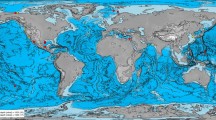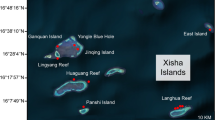Abstract
Lake Van harbors the largest known microbialites on Earth. The surface of these huge carbonate pinnacles is covered by coccoid cyanobacteria whereas their central axis is occupied by a channel through which neutral, relatively Ca-enriched, groundwater flows into highly alkaline (pH ~9.7) Ca-poor lake water. Previous microscopy observations showed the presence of aragonite globules composed by rounded nanostructures of uncertain origin that resemble similar bodies found in some meteorites. Here, we have carried out fine-scale mineralogical and microbial diversity analyses from surface and internal microbialite samples. Electron transmission microscopy revealed that the nanostructures correspond to rounded aragonite nanoprecipitates. A progressive mineralization of cells by the deposition of nanoprecipitates on their surface was observed from external towards internal microbialite areas. Molecular diversity studies based on 16S rDNA amplification revealed the presence of bacterial lineages affiliated to the Alpha-, Beta- and Gammaproteobacteria, the Cyanobacteria, the Cytophaga-Flexibacter-Bacteroides (CFB) group, the Actinobacteria and the Firmicutes. Cyanobacteria and CFB members were only detected in surface layers. The most abundant and diverse lineages were the Firmicutes (low GC Gram positives). To the exclusion of cyanobacteria, the closest cultivated members to the Lake Van phylotypes were most frequently alkaliphilic and/or heterotrophic bacteria able to degrade complex organics. These heterotrophic bacteria may play a crucial role in the formation of Lake Van microbialites by locally promoting carbonate precipitation.







Similar content being viewed by others
References
Altermann W (2004) Precambrian stromatolites: problems in definition, classification, morphology and stratigraphy. In: Eriksson PG, Altermann W, Nelson DR, Mueller WU, Catuneanu O (eds) The Precambrian earth: tempos and events. Elsevier, Amsterdam, pp 564–574
Altschul SF, Madden TL, Schaffer AA, Zhang J, Zhang Z, Miller W, Lipman DJ (1997) Gapped BLAST and PSI-BLAST: a new generation of protein database search programs. Nucleic Acids Res 25:3389–3402
Arp G, Reimer A, Reitner J (2001) Photosynthesis-induced biofilm calcification and calcium concentrations in Phanerozoic oceans. Science 292:1701–1704
Awramik SM (1971) Precambrian stromatolite diversity: reflection on metazoan appearance. Science 174:825–827
Benzerara K, Menguy N, Guyot F, Dominici C, Gillet P (2003) Nanobacteria-like calcite single crystals at the surface of the Tataouine meteorite. Proc Natl Acad Sci USA 100:7438–7442
Burns BP, Goh F, Allen M, Neilan BA (2004) Microbial diversity of extant stromatolites in the hypersaline marine environment of Shark Bay, Australia. Environ Microbiol 6:1096–1101
Cao X, Liu X, Dong X (2003) Alkaliphilus crotonatoxidans sp. nov., a strictly anaerobic, crotonate-dismutating bacterium isolated from a methanogenic environment. Int J Syst Evol Microbiol 53:971–975
Chafetz HS, Buczynski C (1992) Bacterially induced lithification of microbial mats. Palaios 7:277–293
Dravis JJ (1983) Hardened subtidal stromatolites, Bahamas. Science 219:385–386
Duckworth AW, Grant S, Grant WD, Jones BE, Meijer D (1998) Dietzia natronolimnaios sp. nov., a new member of the genus Dietzia isolated from an east African soda lake. Extremophiles 2:359–66
Folk RL (1993) SEM imaging of bacteria and nannobacteria in carbonate sediments and rocks. J Sed Petrol 63:990–999
Francis CA, Tebo BM (2002) Enzymatic manganese(II) oxidation by metabolically dormant spores of diverse Bacillus species. Appl Environ Microbiol 68:874–880
Francis CA, Casciotti KL, Tebo BM (2002) Localization of Mn(II)-oxidizing activity and the putative multicopper oxidase, MnxG, to the exosporium of the marine Bacillus sp. strain SG-1. Arch Microbiol 178:450–456
Grant WD (1992) Alkaline environments. In: Lederberg J (ed) Encyclopedia of Microbiology. Academic, London, pp 73–80
Grant S, Grant WD, Jones BE, Kato C, Li L (1999) Novel archaeal phylotypes from an East African alkaline saltern. Extremophiles 3:139–45
Grotzinger JP (1990) Geochemical model for Proterozoic stromatolite decline. Amer J Sci 290-A:80–103
Grotzinger JP, Knoll AH (1999) Stromatolites in Precambrian carbonates: evolutionary mileposts or environmental dipsticks? Annu Rev Earth Planet Sci 27:313–358
Hammes F, Boon N, de Villiers J, Verstraete W, Siciliano SD (2003) Strain-specific ureolytic microbial calcium carbonate precipitation. Appl Environ Microbiol 69:4901–4909
Humayoun SB, Bano N, Hollibaugh JT (2003) Depth distribution of microbial diversity in Mono Lake, a meromictic soda lake in California. Appl Environ Microbiol 69:1030–1042
Jobb G (2002) TREEFINDER, Distributed by the author at http://www.treefinder.de
Jones BE, Grant WD, Duckworth AW, Owenson GG (1998) Microbial diversity of soda lakes. Extremophiles 2:191–200
Kawaguchi T, Decho AW (2002) Isolation and biochemical characterization of extracellular polymeric secretions (EPS) from modern soft marine stromatolites (Bahamas) and its inhibitory effect on CaCO3 precipitation. Prep Biochem Biotechnol 32:51–63
Kazmierczak J, Kempe S (2003) Modern terrestrial analogues for the carbonate globules in Martian meteorite ALH84001. Naturwissenschaften 90:167–72
Kazmierczak J, Kempe S, Altermann W (2004) Microbial origin of Precambrian carbonates: Lessons from modern analogues. In: Eriksson PG, Altermann W, Nelson DR, Mueller WU, Catuneanu O (eds) The Precambrian Earth: Tempos and Events. Elsevier, Amsterdam, pp 545–556
Kempe S, Kazmierczak J (1990) Calcium carbonate supersaturation and the formation of in situ calcified stromatolites. In: Ittekott VA, Kempe S, Michaelis W, Spitzy A (eds) Facets of Modern Biogeochemistry. Springer, Berlin, pp 255–278
Kempe S, Kazmierczak J (1993) Satonda Crater Lake, Indonesia: Hydrogeochemistry and biocarbonates. Facies 28:1–32
Kempe S, Kazmierczak J (1994) The role of alkalinity in the evolution of ocean chemistry, organization of living systems, and biocalcification processes. In: Doumenge F, Allemand D, Toulemont A (eds), Past and present biomineralization processes. Considerations about the carbonate cycle, Inst Océanogr Bull, no spec 13: 61–117
Kempe S, Kazmierczak J, Landmann G, Konuk T, Reimer A, Lipp A (1991) Largest known microbialites discovered in Lake Van, Turkey. Nature 349:605–608
Knorre H, Krumbein WE (2000) Bacterial calcification. In: Riding RE, Awramik SM (eds) Microbial sediments. Springer, Berlin, pp 25–31
Krumbein WE (1979) Calcification by bacteria and algae. In: Trudinger PA, Swaine DJ (eds) Biogeochemical cycling of mineral-forming elements. Elsevier, Amsterdam, pp 47–68
Lee YN (2003) Calcite production by Bacillus amyloquefaciens CMB01. J Microbiol 41:345–348
Logan BW (1961) Cryptozoon and associated stromatolites from the Recent, Shark Bay, Western Australia. J Geol 69:517–533
López-Archilla A, Moreira D, López-García P, Guerrero C (2004) Phytoplankton diversity and cyanobacterial dominance in a hypereutrophic shallow lake with biologically-produced alkaline pH. Extremophiles 8:109–115
Ma Y, Zhang W, Xue Y, Zhou P, Ventosa A, Grant WD (2004) Bacterial diversity of the Inner Mongolian Baer Soda Lake as revealed by 16S rRNA gene sequence analyses. Extremophiles 8:45–51
Marquis RE, Shin SY (1994) Mineralization and responses of bacterial spores to heat and oxidative agents. FEMS Microbiol Rev 14:375–379
Merz M (1992) The biology of carbonate precipitation by cyanobacteria. Facies 26:81–102
Muliukin AL, Sorokin VV, Loiko NG, Suzina NE, Duda VI, Vorob’eva EA, El-Registan GI (2002) Comparative study of the elemental composition of vegetative and dormant microbial cells. Mikrobiologiia 71:37–48
Neilan BA, Burns BP, Relman DA, Lowe DR (2002) Molecular identification of cyanobacteria associated with stromatolites from distinct geographical locations. Astrobiology 2:271–280
Obst M, Sallam A, Luftmann H, Steinbuchel A (2004) Isolation and characterization of gram-positive cyanophycin-degrading bacteria-kinetic studies on cyanophycin depolymerase activity in aerobic bacteria. Biomacromolecules 5:153–161
Paerl HW, Pinckney JL, Steppe TF (2000) Cyanobacterial-bacterial mat consortia: examining the functional unit of microbial survival and growth in extreme environments. Environ Microbiol 2:11–26
Paerl HW, Steppe TF, Reid RP (2001) Bacterially mediated precipitation in marine stromatolites. Environ Microbiol 3:123–130
Page RD (1996) TreeView: an application to display phylogenetic trees on personal computers. Comput Appl Biosci 12:357–358
Pedone VA, Folk RL (1996) Formation of aragonite cement by nannobacteria in the Great Salt Lake, Utah. Geology 24:763–765
Pentecost A, Bauld J (1988) Nucleation of calcite on the sheaths of cyanobacteria using a simple diffusion cell. Geomicrobiol J 6:129–135
Philippe H (1993) MUST, a computer package of Management Utilities for Sequences and Trees. Nucleic Acids Res 21:5264–5272
Picossi S, Valladares A, Flores E, Herrero A (2004) Nitrogen-regulated genes for the metabolism of cyanophycin, a bacterial nitrogen reserve polymer: expression and mutational analysis of two cyanophycin synthetase and cyanophycinase gene clusters in heterocyst-forming cyanobacterium Anabaena sp. PCC 7120. J Biol Chem 279:11582–11592
Rees HC, Grant WD, Jones BE, Heaphy S (2004) Diversity of Kenyan soda lake alkaliphiles assessed by molecular methods. Extremophiles 8:63–71
Reichenbach H (1999a) The Genus Lysobacter. In: Dworkin M (ed), The Prokaryotes: An evolving electronic resource for the microbiological community, Springer-Verlag, Berlin, p http://link.springer-ny.com/link/service/books/10125/
Reichenbach H (1999b) The order Cytophagales. In Dworkin M (Ed), The Prokaryotes: An evolving electronic resource for the microbiological community, Springer-Verlag, http://link.springer-ny.com/link/service/books/10125/
Reid RP, Browne KM (1991) Intertidal stromatolites in a fringing Holocene reef complex in the Bahamas. Geology 19:15–18
Reid RP, Visscher PT, Decho AW, Stolz JF, Bebout BM, Dupraz C, Macintyre IG, Paerl HW, Pinckney JL, Prufert-Bebout L, Steppe TF, DesMarais DJ (2000) The role of microbes in accretion, lamination and early lithification of modern marine stromatolites. Nature 406:989–992
Reid RP, James NP, Macintyre IG, Dupraz CP, Burne RV (2003) Shark Bay stromatolites: Microfabrics and reinterpretation of origins. Facies 49:45–53
Riding R (1982) Cyanophyte calcification and changes in ocean chemistry. Nature 299:814–815
Rivadeneyra MA, Delgado G, Soriano M, Ramos-Cormenzana A, Delgado R (1999) Biomineralization of carbonates by Marinococcus albus and Marinococcus halophilus isolated from the Salar de Atacama (Chile). Curr Microbiol 39:53–57
Rodriguez-Navarro C, Rodriguez-Gallego M, Ben Chekroun K, Gonzalez-Munoz MT (2003) Conservation of ornamental stone by Myxococcus xanthus-induced carbonate biomineralization. Appl Environ Microbiol 69:2182–2193
Stolz JF, Feinstein TN, Salsi J, Visscher PT, Reid RP (2001) TEM analysis of microbial mediated sedimentation and lithification in modern marine stromatolites. Am Mineral 86:826–833
Stougaard P, Jorgensen F, Johnsen MG, Hansen OC (2002) Microbial diversity in ikaite tufa columns: an alkaline, cold ecological niche in Greenland. Environ Microbiol 4:487–493
Thompson JD, Gibson TJ, Plewniak F, Jeanmougin F, Higgins DG (1997) The ClustalX windows interface: flexible strategies for multiple sequence alignment aided by quality analysis tools. Nucleic Acids Res 24:4876–4882
Visscher PT, Reid RP, Bebout BM, Hoeft SE, Macintyre IG, Thompson JA (1998) Formation of lithified micritic laminae in modern marine stromatolites (Bahamas): The role of sulfur cycling. Am Mineral 83:1482–1493
Visscher PT, Reid PR, Bebout BM (2000) Microscale observations of sulfate reduction: Correlation of microbial activity with lithified micritic laminae in modern marine stromatolites. Geology 28:919–922
Walter MR (1983) Archaean stromatolites: evidence of Earth’s earliest benthos. In: Schopf JW (ed) Earth’s earliest biosphere, its origin and evolution. Princeton University Press, Princeton, pp 187–213
Walter MR, Heys GR (1985) Links between the rise of metazoa and the decline of stromatolites. Precambr Res 29:149–174
Yi H, Chun J (2004) Hongiella mannitolivorans gen. nov., sp. nov., Hongiella halophila sp. nov. and Hongiella ornithinivorans sp. nov., isolated from tidal flat sediment. Int J Syst Evol Microbiol 54:157–162
Yumoto I, Nakamura A, Iwata H, Kojima K, Kusumoto K, Nodasaka Y, Matsuyama H (2002) Dietzia psychralcaliphila sp. nov., a novel, facultatively psychrophilic alkaliphile that grows on hydrocarbons. Int J Syst Evol Microbiol 52:85–90
Acknowledgements
This work was financed by an ATIP grant of the CNRS to Purificación López-García and the French GDR Exobiologie. Support of the Foundation for Polish Science to Józef Kazmierczak and the Deutsche Forschungsgemeinschaft to Stephan Kempe is acknowledged.
Author information
Authors and Affiliations
Corresponding author
Additional information
Communicated by W.D. Grant
Rights and permissions
About this article
Cite this article
López-García, P., Kazmierczak, J., Benzerara, K. et al. Bacterial diversity and carbonate precipitation in the giant microbialites from the highly alkaline Lake Van, Turkey. Extremophiles 9, 263–274 (2005). https://doi.org/10.1007/s00792-005-0457-0
Received:
Accepted:
Published:
Issue Date:
DOI: https://doi.org/10.1007/s00792-005-0457-0




